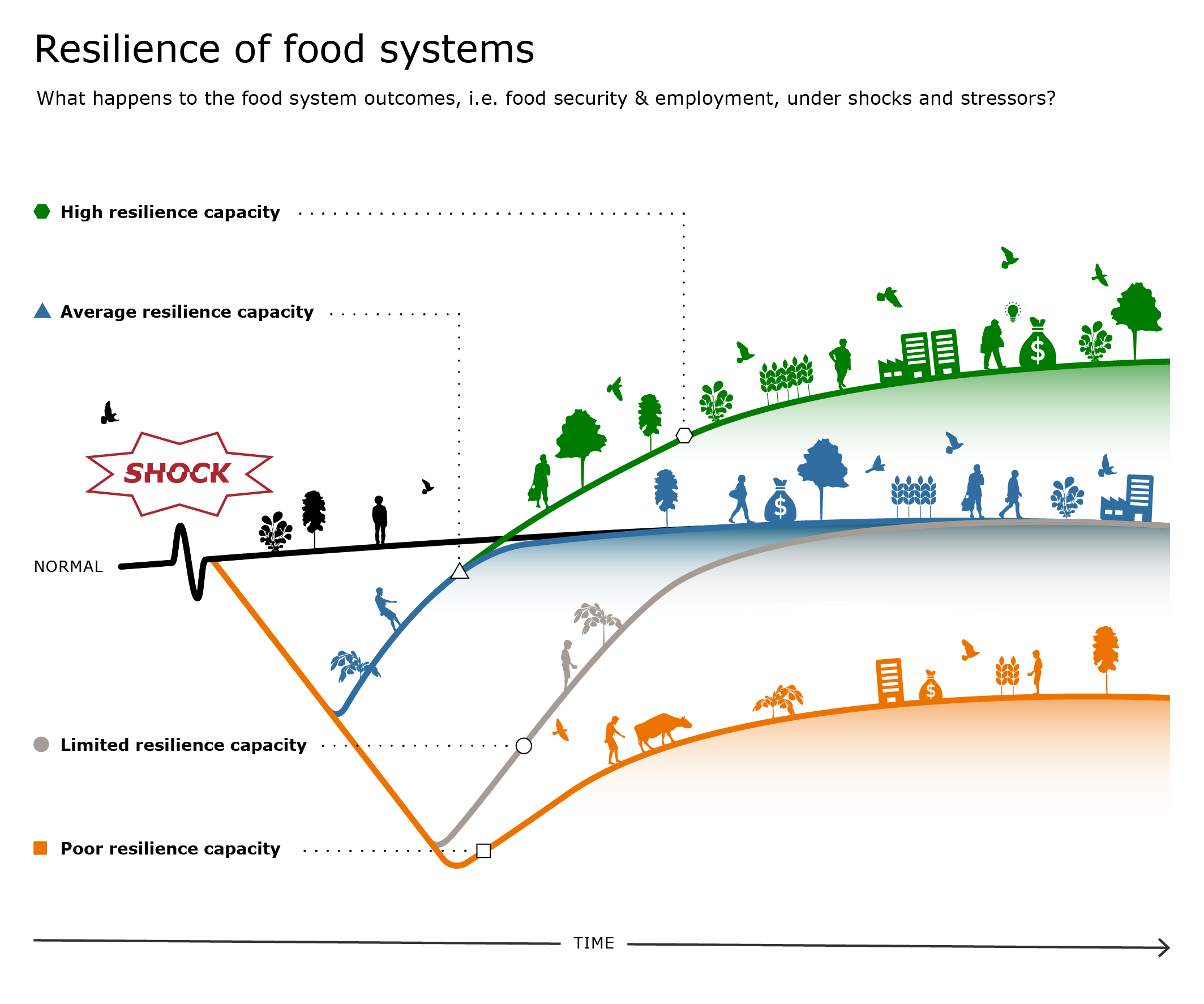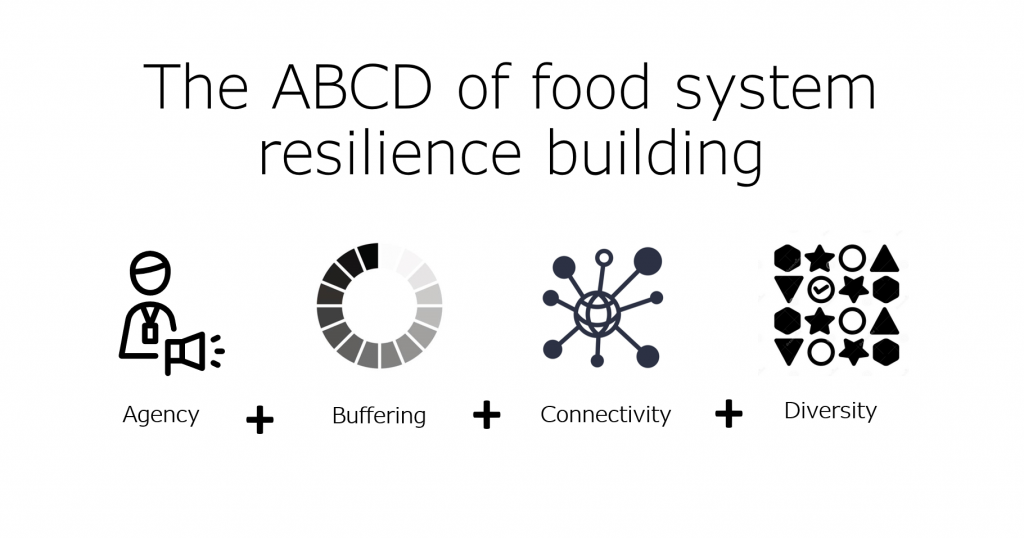Food system resilience: Towards a joint understanding and implications for policy
This is part 9 of a blog series on food systems. This article was written by Bart de Steenhuijsen Piters, Emma Termeer, Deborah Bakker, Hubert Fonteijn and Herman Brouwer.
The COVID-19 crisis is just one in a series of shocks and stressors that exemplify the importance of building resilient food systems. The global food crisis of 2008 revealed how a convergence of different market shocks and disruptions in food production can cause dramatic increases in global food prices and food shortages. This crisis has, in many cases, compounded the impacts of existing shocks and crises, such as droughts, floods, conflict and insecurity. Despite its apparent resilience under the pressure of the COVID-19 pandemic so far, the global food system remains vulnerable.
Food system resilience presents a paradox: even when global food markets prove to be quite resilient in the face of different shocks and crises, desired outcomes such as food and nutrition security are not ensured for all. To ensure that desired food system outcomes are less fluctuating, policy makers and other important stakeholders need a common narrative on food system resilience. The purpose of this blog is to work towards a joint understanding of food system resilience and its implications for policy making.
Key messages in Food System Resilience
We identify four key messages:
1. Building food system resilience is necessary to withstand shocks and stressors and maintain progress towards desired outcomes: food and nutrition security and equitable livelihoods for all in a healthy ecosystem.
2. We identify four key properties of building resilient food systems: ensuring Agency, creating Buffers, stimulating Connectivity, and enhancing Diversity throughout the system.
3. Implementing these properties will enhance the capacity of food systems to anticipate, prevent, absorb, and adapt to the impacts of shocks and stressors.
4. Building resilience through these key properties requires transformation of the entire system and this raises questions about the politics and governance of markets and broader food systems.
Anticipate, prevent, absorb and adapt
The delivery of desired outcomes depends on the ability of food systems to anticipate, prevent, absorb, and adapt to the impacts of shocks and stressors. Food system resilience issues are far from simple to solve. The complex interdependencies within our food systems involve all aspects of life: natural, political, economic, social and cultural. It is therefore key to start from a common understanding between all stakeholders of what food system resilience entails. From there, we can identify the steps that are needed to reform the governance of food systems to obtain and secure the outcomes that we need as a society.
Food system resilience

We understand food system resilience as the capacity of food systems to deliver desired outcomes in the face of shocks and stressors. Enhancing food system resilience involves a more complex task than just ensuring the stable delivery of food and nutrition security or other desired outcomes. For example, expanding or intensifying agricultural production may positively contribute to food and nutrition security, but it will also increase the likelihood of pollution and potential loss of biodiversity.
Moreover, benefits and losses are often not distributed evenly across stakeholders in food systems. As resilience is not an absolute measure, it is important to take into account who has the power to define it. The awareness of such interactions and trade-offs is at the core of approaches to describe, diagnose, and develop interventions in food systems. Building on a common conceptual understanding of resilience in food systems is necessary to avoid that the concept causes confusion and miscommunication between different stakeholders.
Four properties that define response capacity
From the vast literature on resilience, we identify four food system properties that define the response capacity of food systems. These four properties are not exhaustive, but they are always recognizable in systems that are resilient. We suggest that policy makers and other stakeholders recognize what we present as the A B C D of resilience building:
Agency: the means and capacities of people to mitigate risks and to respond to shocks.
Buffering: resources to fall back on in the face of shocks and stressors.
Connectivity: the interconnection of and communication between actors and market segments.
Diversity: diversity at different scales and in different places, from production to consumption and from farm level to regional diversity.

Governance for food system resilience
Most food systems across the globe do not deliver all the outcomes that society expects. Over time, many food systems have lost levels of agency, buffering capacity, connectivity or diversity. One of the principal causes of a food system’s failure to evolve in desired directions is their governance.
Governance encompasses the rules, authorities and institutions that coordinate, manage and steer food systems: not just government, but also markets, cultural traditions and networks, and non-state actors such as businesses and civil society organisations. Governance is inherently political: as a result of conflicting interests and power imbalances, food systems fail to deliver equitable and just access to food. Moreover, the impacts of shocks and stressors are not evenly distributed across actors in the food system. Socio-political differentiation and economic inequality are often overlooked in relation to food system resilience, but these factors need to be taken into account to effectively address unequal impacts and outcomes.
For example, monopolies by big private sector players, at the expense of a multitude of smaller players, have a potentially negative impact on the overall resilience of food systems. Political economic analysis of the governance model will expose any imbalances in power and interests. Such imbalances are increasing worldwide in food systems where concentration of big corporations is observed. Concentrated firms can shape markets, shape technology and innovation agendas, and shape policy and governance frameworks.
To conclude
Over time, food systems have delivered more and new foods, as well as economic opportunities for many people. At the same time, food systems continue to contribute heavily to global warming, waste problems, pollution, obesity, chronic disease and social inequality. This is why we argue that building food system resilience is not only important to withstand and recover from shocks and stressors, but also to maintain progress towards desired outcomes, such as food and nutrition security and equitable livelihoods for all. Even if a system is resilient, specific groups in society may still be vulnerable.
As mentioned at the beginning of this blog, we anticipate more shocks and stressors to food systems in the nearby future. These challenges seem to be unavoidable, but higher levels of resilience will make our food systems better prepared and capable of absorbing their effects without jeopardizing essential contributions by food systems to our livelihoods. This blog has highlighted the importance of more inclusive governance to direct food system transformation towards such higher levels of resilience.
We conclude that we cannot leave this to the market, but that democratic and before all independent, credible institutions are needed to create the necessary transparency between actors as to their interests, power and influence. Aligning these interests is never easy, and must be accompanied by collective negotiation and conflict management processes especially in cases where interests strongly diverge. This is key to create the conditions for transformation towards sustainable, inclusive and resilient food systems.
This blog is a short read of the paper Food System Resilience. Read more about the paper.
Read more
- WUR Research Theme: Food Systems
- WUR Research Programme: Food Security and the value of water
- Applying a food systems approach: the key to Zero Hunger in 2030
- A food system approach leads to food security

